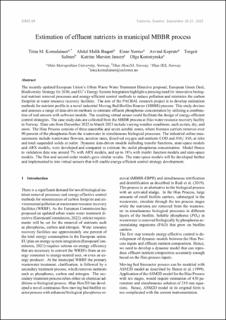| dc.contributor.author | Komulainen, Tiina M. | |
| dc.contributor.author | Baqeri, A. Malik | |
| dc.contributor.author | Nermo, Einar | |
| dc.contributor.author | Keprate, Arvind | |
| dc.contributor.author | Saltnes, Torgeir | |
| dc.contributor.author | Jansen, Katrine M. | |
| dc.contributor.author | Korostynska, Olga | |
| dc.date.accessioned | 2023-11-14T08:18:58Z | |
| dc.date.available | 2023-11-14T08:18:58Z | |
| dc.date.created | 2023-11-08T16:19:54Z | |
| dc.date.issued | 2023 | |
| dc.identifier.citation | Linköping Electronic Conference Proceedings. 2023, . | en_US |
| dc.identifier.issn | 1650-3686 | |
| dc.identifier.uri | https://hdl.handle.net/11250/3102305 | |
| dc.description.abstract | The recently updated European Union’s Urban Waste Water Treatment Directive proposal, European Green Deal,
Biodiversity Strategy for 2030, and EU’s Energy System Integration highlight a pressing need for innovative biolog-
ical nutrient removal processes and energy-efficient control methods to reduce pollution and minimize the carbon
footprint at water resource recovery facilities. The aim of the PACBAL research project is to develop estimation
methods for nutrient profile in a novel industrial Moving Bed Biofilm Reactor (MBBR) process. This study devises
and assesses a range of data-driven methods to estimate effluent phosphorus concentration by utilizing a combina-
tion of real sensors with software models. The resulting virtual sensor could facilitate the design of energy-efficient
control strategies. The case study data are collected from the MBBR process at Hias water resource recovery facility
in Norway. Data sets from December 2022 to March 2023 include varying weather conditions, such as rain, dry, and
snow. The Hias Process consists of three anaerobic and seven aerobic zones, where biomass carriers removes over
90 percent of the phosphorus from the wastewater in simultaneous biological processes. The industrial online mea-
surements include wastewater flowrate, aeration rates, dissolved oxygen and nutrients COD and NO2/ NO3 at inlet
and total suspended solids at outlet. Dynamic data-driven models indluding transfer functions, state-space models
and ARX models, were developed and compared to estimate the outlet phosphorus concentration. Model fitness
to validation data was around 7% with ARX models, and up to 18% with tranfer function models and state-space
models. The first and second order models gave similar results. The state-space models will be developed further
and implemented to into virtual sensors that will enable energy-efficient control strategy development. | en_US |
| dc.language.iso | eng | en_US |
| dc.rights | Navngivelse 4.0 Internasjonal | * |
| dc.rights.uri | http://creativecommons.org/licenses/by/4.0/deed.no | * |
| dc.title | Estimation of effluent nutrients in municipal MBBR process | en_US |
| dc.type | Peer reviewed | en_US |
| dc.type | Journal article | en_US |
| dc.description.version | publishedVersion | en_US |
| cristin.ispublished | true | |
| cristin.fulltext | preprint | |
| cristin.qualitycode | 1 | |
| dc.identifier.doi | https://doi.org/10.3384/ecp200037 | |
| dc.identifier.cristin | 2194176 | |
| dc.source.journal | Linköping Electronic Conference Proceedings | en_US |
| dc.source.pagenumber | 8 | en_US |

